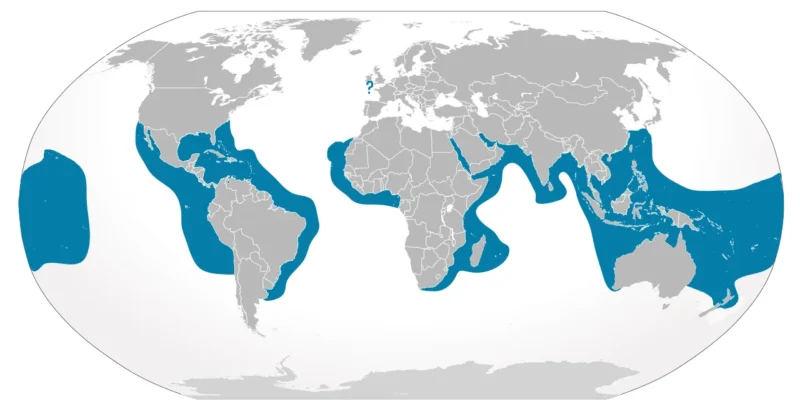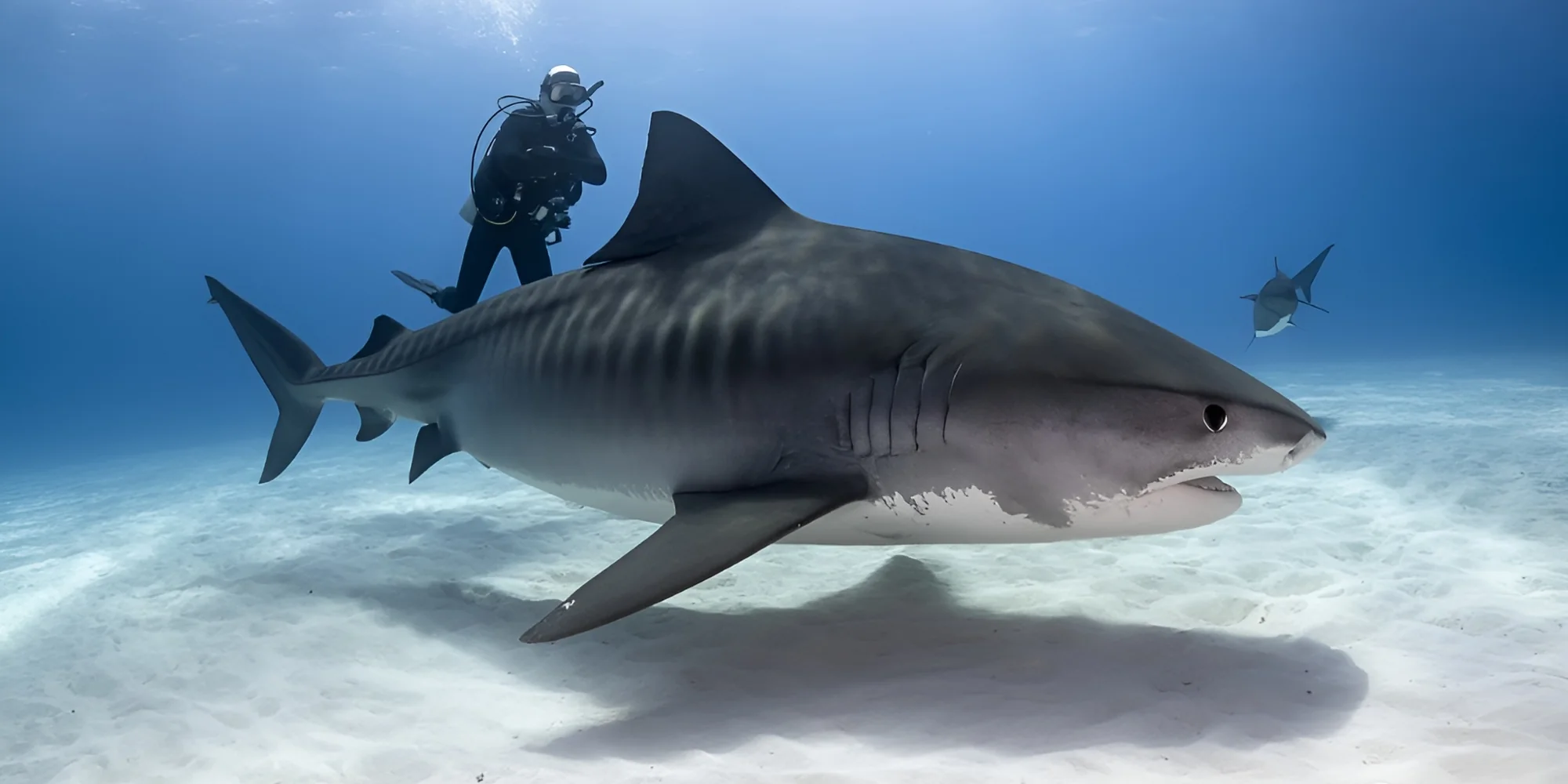Body Structure, Characteristics & Anatomy
Anatomy and body structure of the tiger shark
A look at the external characteristics
The tiger shark, scientifically known as Galeocerdo cuvier, is one of the largest and most impressive shark species in the world's oceans. It owes its name to the characteristic striped pattern, which is especially visible in juveniles. As the shark ages, these dark vertical stripes fade but usually remain recognizable as shadows.
Tiger sharks have a strong, torpedo-shaped body that is optimized for fast and powerful swimming. The upper side is usually colored gray-blue to olive, while the underside is strikingly lighter, often whitish or yellowish. This so-called countershading helps the shark visually camouflage itself both from above and below.
Head and Snout
The head of the tiger shark is broad and short. Its snout appears blunt and slightly flattened, giving the animal a robust appearance. The nostrils are located on the underside and are surrounded by sensory pits (ampullae of Lorenzini) that detect electric fields – an important aid in hunting.
Eyes and sensory organs
The eyes of the tiger shark are large, round, and highly sensitive to light. Behind each eye is a small spiracle, which in bottom-dwelling sharks is often used for breathing – though in the tiger shark it is more of a rudimentary structure. Its sensory system allows it to hunt efficiently even in low light or murky water.
Gills and skin structure
Five gill slits on each side of the body allow the shark to absorb oxygen from the water. The skin is covered with tiny, tooth-like scales – called placoid scales. They make the skin rough like sandpaper, but at the same time reduce water resistance and protect against parasites and injuries.
Fin arrangement
The tiger shark has two dorsal fins, with the first being large, sickle-shaped, and prominent. The second is noticeably smaller and located closer to the tail fin. Its pectoral fins are strong and broad, while the pelvic fins are rather narrow. The tail fin is asymmetrical: the upper lobe is longer than the lower one and provides powerful forward propulsion.
Teeth and dentition
The dentition is one of the most striking anatomical features. The teeth are broad, triangular, and strongly serrated on the sides – ideal for cutting prey. Unlike many shark species, the upper and lower jaw teeth are almost identical in shape. Tiger sharks can use these teeth to cut through hard objects like turtle shells or bones. Broken teeth are continuously replaced – new teeth grow from rows inside the jaw.
Sex Differences: Male vs. Female
Body Size and Weight
A clearly visible difference between the sexes lies in body size. Female tiger sharks are on average larger than their male counterparts. While males are usually between 2.5 and 3.5 meters long, females often reach lengths of over 4 meters. Individual specimens can even grow longer than 5 meters. Weight also varies accordingly – females often weigh several hundred kilograms more.
Reproductive Organs and External Features
A reliable distinguishing feature are the so-called claspers – paired extensions on the pelvic fins of males that serve for reproduction. These are clearly visible from the outside and are completely absent in females. Apart from that, both sexes are very similar externally in terms of color, fin structure, and body shape.
Maturation and Growth
Male tiger sharks reach sexual maturity earlier, at a body length of about 2.25 to 2.9 meters. Females usually require a length of at least 2.5 to 3.5 meters. This is related to the more complex reproductive system, as females give birth to live young and undergo longer gestation periods.
Distribution & Habitat
Global distribution
The tiger shark is a widespread shark species found in almost all tropical and warm-temperate marine regions of the world. Its range extends across the Atlantic, the Indian Ocean, and the Pacific. It is especially common in waters between the 40th parallel north and south latitude.
In the western Atlantic, the tiger shark lives along the east coast of North and South America – from the coasts of Florida and the Caribbean to Brazil. In the eastern Atlantic, it is found from West Africa to the Cape Verde Islands. Occasionally, individuals are also sighted further north, mainly due to seasonal migrations and warm ocean currents.
In the Indian Ocean, the tiger shark is found off the coasts of East Africa, the Maldives, around Madagascar, and in waters surrounding the Indian subcontinent. In the Pacific, it is present in tropical island regions such as Polynesia, Micronesia, and Melanesia, as well as along the coasts of Australia and Southeast Asia. Hawaii, Tahiti, and the Galapagos Islands also belong to its preferred distribution areas.

Typical Habitats
Tiger sharks are highly adaptable and utilize various habitats in the sea. They are found both near the coast and in pelagic, or open ocean, zones. They are especially frequently observed in the following habitats:
Coastal Waters
Shallow, warm coastal regions are among the preferred habitats of the tiger shark. There, they roam sandbanks, lagoons, and bays, often near mangroves or river mouths. These zones not only offer abundant food but also structural diversity through underwater landscapes such as seagrass meadows or rock formations.
Coral Reefs and Reef Edges
Coral reefs are among the most important habitats for the tiger shark. Especially in tropical regions, they regularly patrol along outer reefs and reef edges, where biodiversity is high and food supply is particularly abundant. These areas are also frequently inhabited by turtles, rays, and smaller sharks — all potential prey for the tiger shark.
Open Ocean
Although the tiger shark is often found in coastal areas, it is also among the sharks that travel long distances over open water. It often stays above the continental shelf, where the sea is relatively shallow, but can also use deeper zones down to several hundred meters. In these pelagic areas, the tiger shark searches for migrating fish schools or drifting prey.
Differences Between Age Groups
The use of habitats differs somewhat between young and adult animals. Juveniles usually prefer sheltered, shallower coastal areas where they are relatively safe from larger predators. These so-called nurseries are often located in shallow lagoons or mangrove bays.
Adult tiger sharks, on the other hand, are significantly more mobile and display a broader range of habitats. They sometimes migrate over long distances and move between reef zones, open waters, and coastal areas. In doing so, they often follow seasonal patterns or food availability.
Lifestyle, diet & reproduction
General Lifestyle and Behavior
The tiger shark is considered a solitary animal that only occasionally appears in groups when large food sources are available. On such occasions, a loose hierarchy forms, with larger individuals feeding first while smaller ones wait until the bigger ones are satiated. The animal is mainly active at dusk and night. During the day, it often retreats to coastal or deeper waters, while in the evening it visits shallow waters near the shore.
Tiger sharks move over very large areas. Individual sharks swim up to 16 km per day and often return to the same place only after months. Their range can cover several square kilometers — typically about 23 km². Seasonal migrations lead them into temperate zones during warmer periods and back to tropical waters in winter. Females tend to stay closer to shore more often, especially when pregnant.
Diet Spectrum and Hunting Strategy
The tiger shark has one of the broadest diets in the animal kingdom. Its reputation as the "garbage eater of the sea" comes from the fact that it eats almost anything that fits into its mouth — from mollusks, fish, turtles, rays, smaller shark species, marine mammals, and seabirds to carrion, sea birds, and sometimes even human-made objects. This is due to its strongly serrated teeth, which act like saw blades and can cut through hard shells or bones. Larger individuals tend to prefer turtles, seals, or thick-shelled fish as they grow older, while juveniles mainly prey on small fish and crustaceans.
Its hunting strategy is based on isolation and camouflage. It approaches silently, sneaking up from deeper zones and uses short bursts of speed to overwhelm prey by surprise.

Reproduction and Life Cycle
Tiger sharks are ovoviviparous — this means the young initially develop from large eggs inside the mother's body, then receive nourishment through embryotrophic fluid before being born alive.
| Characteristic | Description |
|---|---|
| Reproduction Cycle | Approximately every three years per female |
| Gestation Period | Approximately 13 to 16 months |
| Litter Size | Between 10 and 82 pups, usually 25 to 40 |
| Size at Birth | Around 51 to 76 cm |
| Sexual Maturity | Males about 2.3 to 2.9 m, females about 2.5 to 3.5 m in length |
| Estimated Lifespan | About 20 to 50 years |
In the northern hemisphere, mating usually takes place between March and May, with births occurring from April to June. In southern regions, mating often happens in November or December, with births between February and March. Young sharks are born in so-called nurseries — typical shallow water areas like lagoons or sheltered river mouths, where they are better protected from larger predators.
After birth, the mother no longer cares for the young. The pups are immediately independent, well camouflaged, and equipped with sharp teeth — however, their chances of survival are low. They reach adulthood only after several years, which is accompanied by a complete change in the flank pattern and the development of a stronger body.
Humans & Tiger Sharks
Myths and Facts
The tiger shark is considered dangerous but is not more aggressive than other large shark species. Worldwide, there are only a few documented incidents involving humans. Most cases are misunderstandings — the shark mistakes a swimmer or surfer for prey. The image of a bloodthirsty predator is greatly exaggerated.
Encounters While Diving
In certain regions, diving with tiger sharks is an integral part of ecotourism. Trained dive guides observe the animals up close — without cages and usually without incidents. Such encounters provide unique experiences while promoting understanding of this fascinating species.
Dive Spots for Encounters with Tiger Sharks
Tiger Beach, Bahamas
Off the coast of Grand Bahama lies the most famous spot: Tiger Beach. Large tiger sharks — mostly females — regularly gather here in clear, shallow waters. Divers can observe them up close. The sharks are considered curious but not aggressive, as long as they are treated with respect.
Fuvahmulah, Maldives
On this remote island of the Maldives, visitors can observe tiger sharks year-round. Through targeted baiting, the animals are attracted to specific locations, allowing for safe and controlled dives. Particularly impressive is the high number of documented individuals in this area.

Aliwal Shoal, South Africa
Near Durban, along the Aliwal Shoal, there is also the opportunity to encounter tiger sharks. So-called “shark dives” take place here – guided dives with experienced guides, during which the animals are observed respectfully.
Hawaii
Hawaii is one of the few places where tiger sharks regularly appear close to shore. Special dive tours make it possible to interact with these animals in a respectful manner – usually under strict regulations and with professional guidance.
Safe diving with tiger sharks
Behavioral recommendations
- Always enter the water with experienced dive guides
- Move calmly and slowly – no sudden gestures
- Hover upright in the water, maintain eye contact
- Never touch the sharks or block their path
- Do not wear shiny equipment
Assess risks realistically
The risk of being injured while diving with tiger sharks is extremely low. When safety rules are followed, encounters are mostly harmless. It is important to treat the animals with respect and be willing not to harass or treat them like in a zoo.
Threats & Population Development
The tiger shark (Galeocerdo cuvier) is one of the largest predators of the world’s oceans. Despite its wide distribution in tropical and subtropical waters, this species faces increasing pressure. Especially hunting by humans and its slow reproductive rate threaten its population. In this article, we take a look at the current challenges regarding the threat and population development of the tiger shark.
Threats to the Tiger Shark
The tiger shark reproduces only every two to three years and produces comparatively few offspring. This biological trait makes it particularly vulnerable to overfishing. In many regions, tiger sharks are deliberately caught—either for commercial reasons or as part of sport fishing. In addition, they often end up unintentionally as bycatch in industrial fishing nets.
Particularly problematic is the trade in shark fins. In some countries, these are considered a delicacy, leading to high demand. Tiger sharks are therefore often killed solely for their fins. Skin, liver oil, and cartilage are also commercially used. Many fishing areas lack adequate regulation, and comprehensive data on actual catch numbers are missing. This makes it difficult to accurately assess the global population.
The International Union for Conservation of Nature (IUCN) currently classifies the tiger shark as "near threatened." This means that the species is not yet immediately at risk of extinction but that a further decline in populations is likely if no protective measures are implemented.

Population development in different regions
The global development of the tiger shark population is difficult to quantify precisely. Long-term and comprehensive surveys are lacking. Nevertheless, regional studies provide clear indications of a decline.
In Australia, data from the so-called Shark Control Program show that tiger shark catch rates have declined by over 70 percent since the 1960s. At the same time, the average body size of the caught animals has decreased. This suggests that particularly larger, sexually mature individuals are disappearing from the populations.
Similar trends can be observed in the Atlantic. There, too, catch numbers have significantly declined over the past decades. Particularly concerning is the increasing capture of young animals before they can reproduce. This negatively affects the regeneration of the populations.
In the Arabian Sea, a decline of the tiger shark population by around 30 percent has been estimated over the past 75 years. Forecasts assume that this trend will continue in the coming decades unless effective protective measures are implemented.
South Africa currently represents an exception. Observations there even show slightly increasing catch numbers. However, scientists warn against concluding a global recovery from regional developments. The worldwide trend continues downward.

















